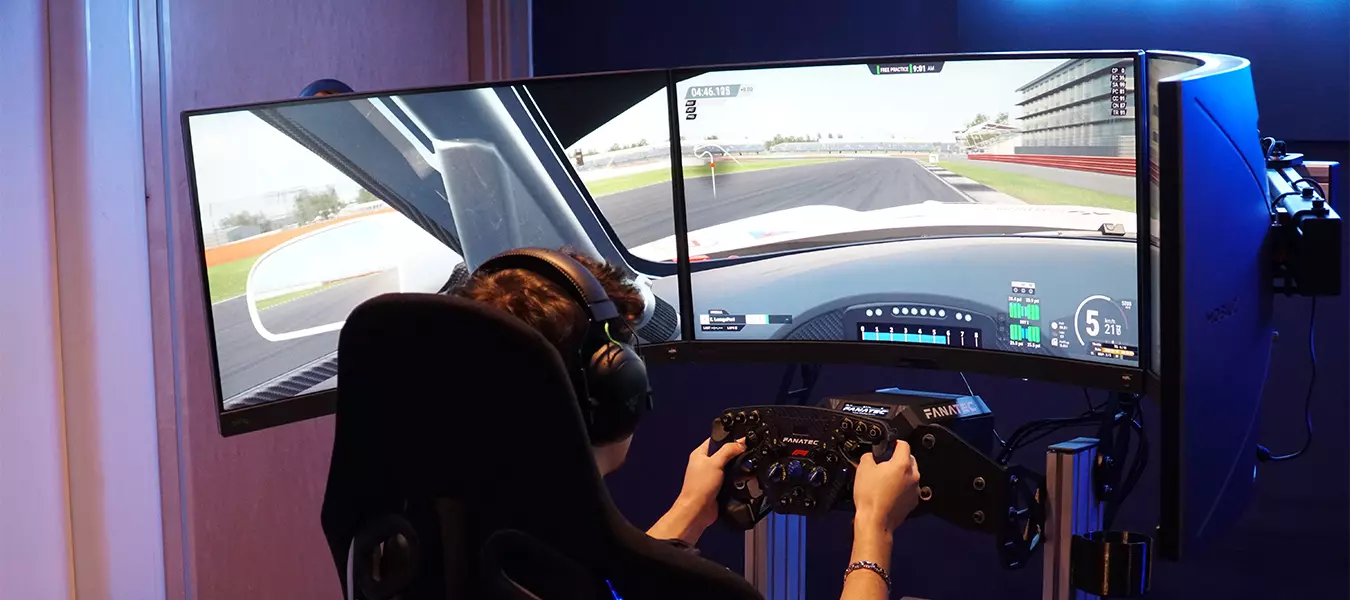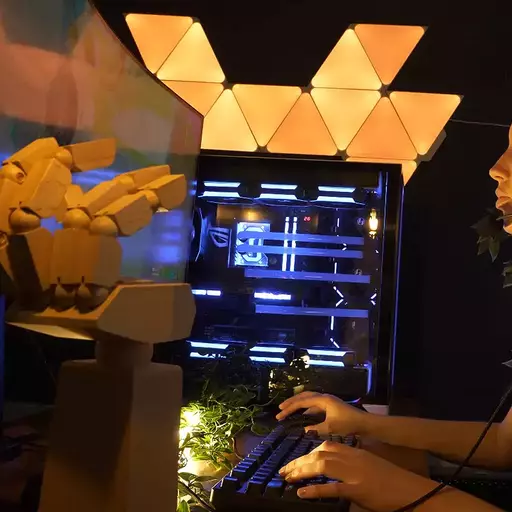If you take your racing seriously, there’s no better way to fully immerse yourself in the back and forth tussle for pole position, than with your own sim racing setup. There are a few bespoke solutions out there, but the best way to make yourself feel like you’re really sitting behind the wheel of your favourite cars, is to actually sit you behind the wheel of your favourite cars. Digitally, at least.
But the best sim racing setups go well beyond just a simple wheel. If you’re willing to put in the time and money to creating it, you can build the ultimate racing experience right in your own home. Combining all the racing hardware you need to feel like you’re really in the action, with a powerful enough computer to run the latest sim racing games at the highest of settings, and the fastest of frame rates.
Here’s how to build the best sim racing setup for the ultimate in racing immersion.
What you need for the best sim racing experience
There’s a lot that goes into creating a realistic simulated racing experience. There’s a reason that the professional race teams spend millions on theirs. But you don’t have to go that far to have an amazing experience. In fact, you can go as far, or as short as you want. You can combine all of the following together, or pick out some pieces that will make your racing experience better, and then either improve or add to them later as you wish.
You'll need a powerful gaming PC to run any sim racing setup, but most of our general advice on building a gaming PC is just as applicable for building a high-end sim racing PC. You may want to consider a capable sound system, too, though a high-end pair of surround sound headphones is often good enough. You may need to consider a display, as well. You can use an existing TV or monitor, but sim racing setups can include a mounted monitor at the right height and distance from the driver to really simulate real world driving.
All that said, the actual racing sim gear you may need and almost certainly want, can be divided into two distinct categories:
- Racing gear: This is all the equipment you use to interact with the game in a more realistic, racing fashion. It includes a racing wheel, racing pedals, a gear stick shift, and a button box for other inputs. You can augment that all further with a racing seat of some kind, too.
- The frame: What are you going to put all of that racing gear on? A racing frame. These can be as casual as a stack of boxes and tables you have handy, or as involved as a bespoke metal framework. There are cheaper and more costly options, but having somewhere to lock down all your racing gear is a must if you want to really thrash it around without fearing knocking something over.
There are also pre-built sim racing setups that include a range of racing gear, a display, a gaming PC, audio, and more so that you don't have to make any decisions about any of it. That can be great if all you want is a straightforward solution, but it's often over priced, lacks the precision and power of high-end racing gear, and doesn't have any of the customization of a custom sim racing setup. That raises the chances of you dealing with a component that doesn't meet your wants and needs and it typically means making later adjustments can be difficult.
The best way to build the ultimate sim racing setup is to choose each component individually, so you get exactly what you want. That's what we're going to look through today.
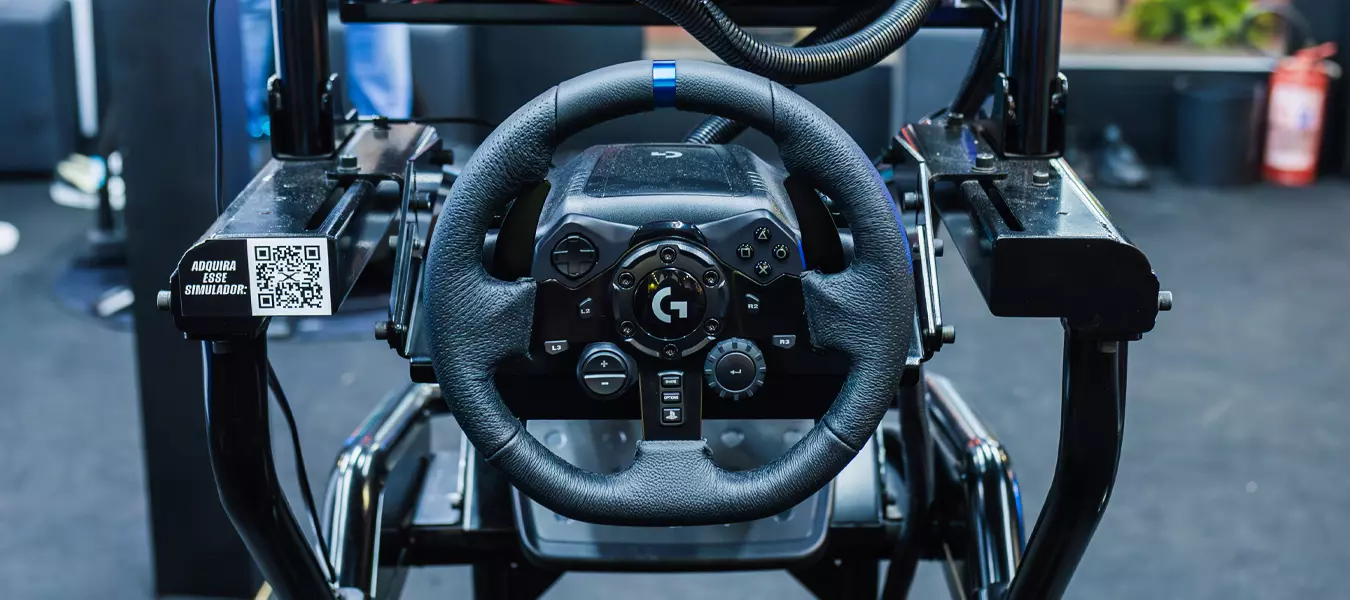
Racing Gear
This is where all the true immersion of a racing sim setup comes from. The feel of the wheel under your fingers, the responsiveness of the pedals, the satisfying tactile feedback of the gear shifter, the sheer customization options with a big button box. It’s what makes a racing sim rig really feel like you’re racing.
There are a number of different components that go into building a racing setup, and some of them are more important than others. We’ll take a look at each of them, along with a few options for each that take into consideration different needs and budgets.
Racing wheels
If you buy any piece of racing equipment to improve your racing setup, it should be this. A racing wheel lets you give real-world-style inputs to your racing game of choice, and get a real-world feel of racing in response. You’re no longer using a controller or keyboard with very-obviously computer-based inputs. You’re gripping a real wheel and turning it like you would a real wheel in a real car. With the right one, it'll fight you all the way too, helping you feel the road under your virtual wheels.
Different wheels will give you different experiences, with some delivering a truly realistic feel with tactile feedback and motors that make you fight the wheel on tight turns. But even some of the more affordable solutions can go a long way to make playing a racing game feel much more like real racing in the real world.
The most important feature of a racing wheel is its force feedback, but that can be achieved in a few different ways. Direct drive wheels offer the most responsive driving experience, with drivers within the wheel giving you that haptic feel of the road under your tyres. It’s more expensive, but tends to give the best experience of any racing wheel type.
Belt driven wheels tend to be a little cheaper, and offer a competitive experience for direct drive wheels, so are worth considering if you want a realistic-feeling wheel without the extreme price tag. Gear driven wheels are great too, even if they are the cheapest type. While their feel isn’t as realistic as the higher-end options, you can still get great gear driven wheels for excellent force feedback.
Also consider comfort and the materials used in the wheel’s construction. Leather is great, but it’s not as comfortable as alcantara, although leather is more durable. Some wheel shapes can be more comfortable to hold too, especially when you consider the location of on-wheel buttons. If you can’t reach them comfortably, better to look elsewhere.
There can also be a difference in design between formula and GT wheels. Beyond the types of games they're designed for. Formula wheels tend to not turn as far, have a more compact design, and have more buttons, while GT wheels will be larger, have longer paddles for gear shifting from different positions on the wheel, and have viewer buttons.
Look out for extra useful features like wireless operation (typically over Bluetooth), as that can make wiring up your sim racing setup that bit easier – although you do then have to factor in charging the battery. Pay close attention to the mounting mechanism, too, as not all wheels are compatible with all wheelbases. Depending on the frame you choose below, your choice of wheel and wheelbase mounting may need to be adjusted, also.
RGB lighting might be a bit of a gimmick with most peripherals, but if you plan to turn off all the lights in your racing room for added immersion, or night time drives, make sure you wheel has LED-lit buttons or you’ll be stuck trying to find them in the dark.
Racing pedals
Racing pedals don’t just add an important element of realism to your racing sim setup, they can allow you to perform advanced driving techniques like trail braking, double-clutching, and fine throttle control, ultimately improving your lap times and giving you greater control of the car. That makes you more likely to win, and makes it more fun to use your newly built racing sim system.
Not all racing pedals are the same, though. Higher end, more expensive models tend to offer greater throttle granularity, letting you use more subtle presses to achieve specific responses from the pedals and your in-game vehicle. They also tend to use load cells to measure the force applied to the pedal, which offer more realistic resistance to your press, and are more sensitive to your inputs.
More affordable pedals tend to be built using potentiometers which measure the distance the pedal has travelled, rather than its direct force. This is a little less accurate, but they are far more affordable to produce so you can save a lot of money by opting for a set of pedals that use potentionmeters.
Look out for pedals which offer some deadzone customisation. This can allow you to rest your foot on the pedal without any input for added comfort. The ability to change pedal position can be really useful, too. Especially if you’re trying to emulate the feel of a real car, or need a specific spacing between pedals because of the design of your racing sim setup.
Construction materials should be considered, as well. These not only affect the comfort of the pedals, but are a major part in how they look. If you’re building the ultimate racing setup to look just how you like it, make sure the pedals match too.
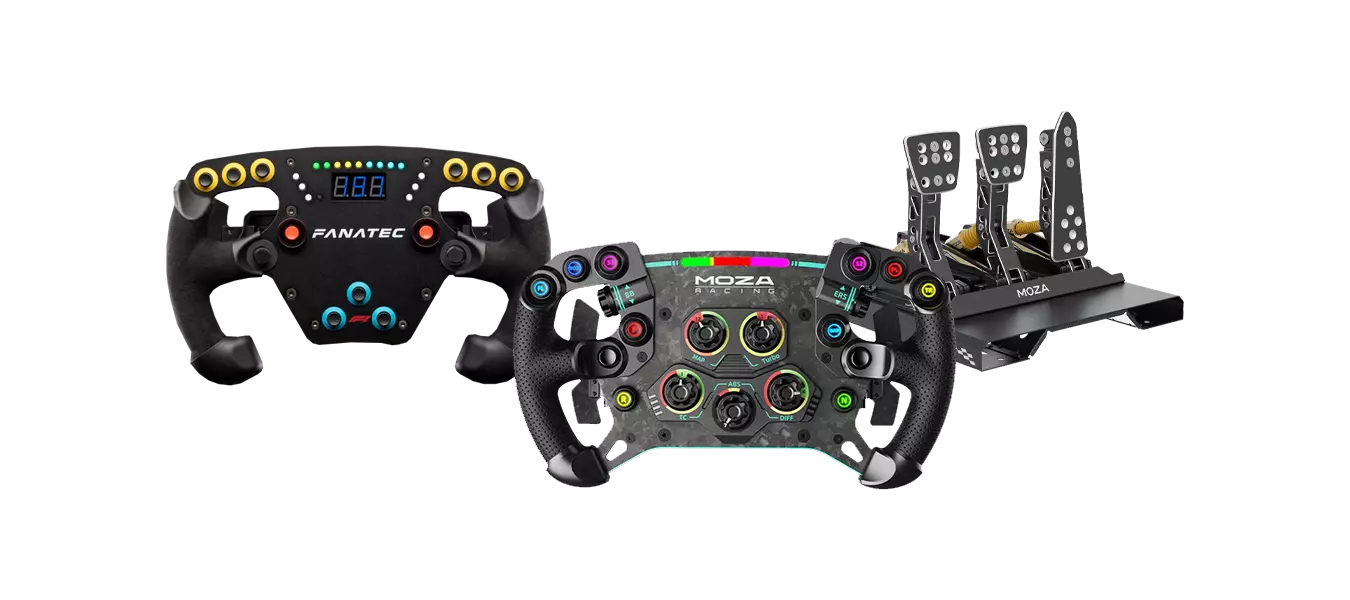
Sim racing gear shifter
Gear shifters are a great way to add another layer of immersion and control to your racing sim setup. Although not every game requires it, being able to manually shift between gears feels great in games that support it – especially when paired with a clutch pedal setup. Some racing wheels have flappy paddle gear shifters you can use if that’s your preference, but for some there’s no substitute for a realistic gear shifter.
But which style is right for you? We have a few recommendations to make, but you’ll want to consider the type of shifter, as they vary dramatically in price, function, and the kind of games they’re designed for.
The most straightforward gear shifter is a sequential one. This is a gear shifter that can only go up or down in gear and gives you that tactile sensation and control of shifting gears manually, without the need to focus on what gear you’re in, or the precise pattern required for shifting up or down, helping you focus on the track. This is most commonly utilised by those playing rally games, and doesn’t typically require a clutch pedal, though they can be used with one.
H-pattern gear shifters offer much greater control over what gear you’re in, letting you jump to any of them at once without moving through the others first. The precise configuration of the different gears and the type of shifter itself will be dependent on the brand and model, but all H-pattern gear shifters give you a higher level of control. You’ll need to include a clutch pedal in most games, but that also adds additional control where you can utilize heel and toe downshifting to improve control of your vehicle while dropping down the gears.
Some gear shifters can be used as both sequential and H-pattern gear shifters, which can give you greater versatility with support for different kinds of racing games. Those models also tend to be the most expensive.
There are also some sequential gear shifters that can be used as both gear shifter and handbrake, depending on how they are configured and whether the game you’re playing supports it.
Button box
Although typically more suited to flight and space simulators, button boxes can also be a great addition to a sim racing setup. If you’re limited by the buttons on your racing wheel, or just want a more authentic, immersive racing experience, then a button box can give you physical controls for just about anything – as long as the game supports button remapping.
You could use it to handle the ignition of the engine, the speed of your wipers, toggle your lights, adjust racing parameters in the car, and more, depending on the game.
Compared to some of the other racing gear in this article, button boxes vary dramatically in their style, build-quality, and features, since not only do the major peripheral manufacturers make them, but they’re a popular home-build for DIY enthusiasts. You can find some great options on auction and classified sites, though those designs do lack a warranty of any kind and the quality cannot be guaranteed.
If you opt for a manufacturer model, the main things to look out for are the number of type of inputs available, the USB-mechanism that it connects with, and its mounting options. You’ll likely want to install your button box somewhere reachable, so having it mountable on your seat, steering wheel mount, or on your racing frame, can be very useful indeed.
Don’t think you need to only use bespoke button boxes, though. Peripherals designed for other uses, like the Elgato Streamdeck, can be particularly useful alternatives – especially if you want buttons that look or behave a certain way when pressed.
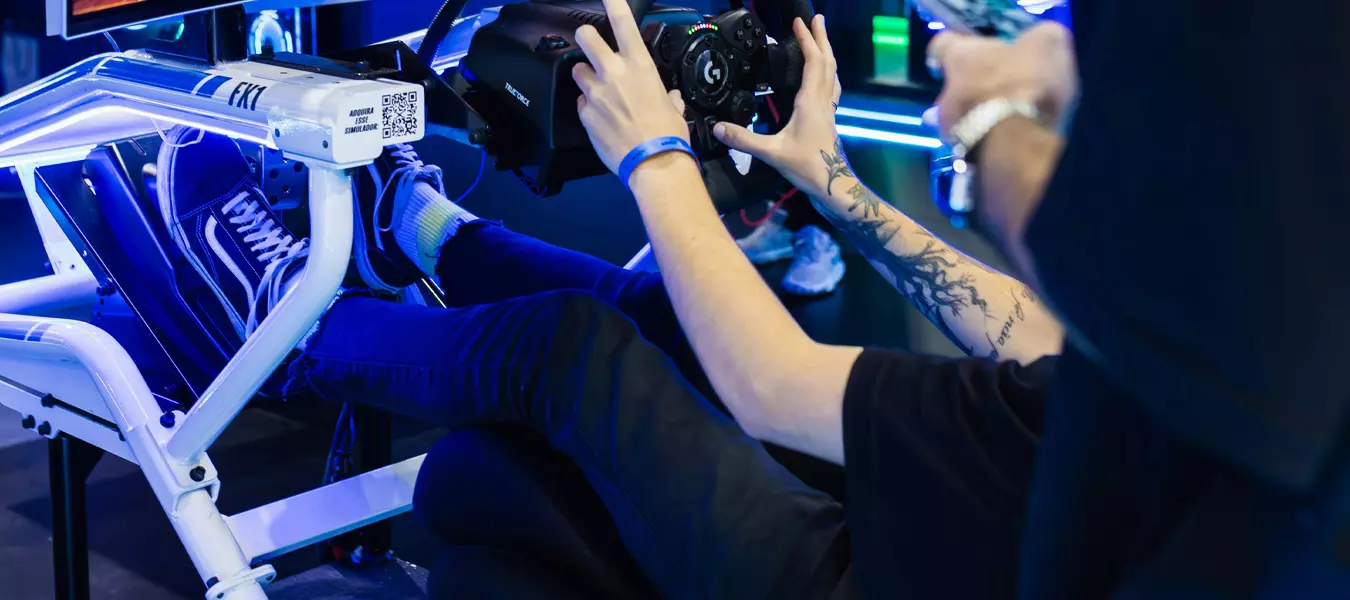
Racing seat
A racing seat might not be an obvious component in a racing sim setup, as you can just sit in your regular old office chair and it’ll work well enough. But if you want to build a custom racing sim setup that gives you a comfortable, stable, and importantly, realistic seat to drive in, then a racing sim seat can make the world of difference.
There’s also nothing quite like a racing seat to show everyone that you take your racing seriously. You’ll look much more the part nestled in the comforting arms of a bucket seat than you will perched on the edge of your sofa.
There are all kinds of racing seats to choose from, so ultimately pick one that you like the look of and will find comfortable for your body type. But if you want to dig into the specifics, you’ll want to consider one of three kinds of racing seat: Formula, GT, or road car.
Seats designed to replicate the formula racing experience will tend to be low profile, getting your centre of gravity as low as possible. Understandably, these would give you the best immersion for a formula or Le Mans-style racing experience, but they’ll work well for most racing games too.
GT racing seats give a more upright racing position, but still keep you ensconced in the arms thanks to the bucket design. These tend to offer a more snug fit, so if you want to feel firmly in place while you race, these can be a good choice. Padding and comfort are very dependent on the model you pick, so choose accordingly.
For the most comfortable racing seat experience, however, road car seats offer another level of padding and support. Inspired by the their real-life counterparts, these seats are designed for plush comfort over long racing sessions, more than they are for replicating the look and feel of a real racing seat. If you’re more interested in making it possible to stay seated for hours for extensive racing sessions, then these sorts of seats might be best for you. For greater racing immersion in non-road-cars, though, the other seat designs might be better.
The Frame
It’s rare in gaming to find an accessory so beneficial to a gaming setup that has no actual impact on the game itself, as a racing frame or cockpit. But when you’re building a sim racing setup, having all of the racing hardware components locked down in a comfortable, reachable position can make the world of difference.
You can just rest your steering wheel on your office desk, stick the pedals on the floor and find somewhere to put the gear shifter, but it’s not the same as having them orientated like they are in a real racing cockpit. There’s just a level of immersion you can only achieve if you have a racing frame to attach it all to. It makes it feel much more like the real deal; even just at the point of getting into the seat.
You don’t have to go all out, though. Sure, the most high-end of sim racing frames have motors and look more like a ‘90s theme park simulator, but there are much-more-modest solutions which work just as well, and even just having a stand for the wheel and pedals can make a huge difference.

All-in-ones
The most simple, comprehensive solution, is an all-in-one sim racing system. These are sometimes called cockpits, or racing simulators, and are designed to include everything you need to build your sim racing rig. These can come with racing gear included, though those tend to be uncommon, overly expensive, and don’t give you the level of customization most sim racers are looking for.
For the more barebones ones that are the frame only, look out for those advertising at low prices. They often come with a lot of optional extras which are really important parts of the design. It’s no good buying a racing sim frame if it doesn’t have a wheel mount, for example.
Regardless of whether they’re trying to upsell you, though, there is a lot of variation in all-in-one racing frame designs. Not only can they look drastically different to one another, but they can support different kinds of racing gear. Some support greater wheelbase torques for more realistic driving in extreme conditions, while others are more limited. There’s a range of different wheelbase mounting options, making some more suited to certain wheel types and brands than others too, so whatever you buy, ensure it’s compatible with everything else.
Some can be put together very quickly, while others can take hours and hours to build. That can be a major selling point if you’ll need to move your racing sim rig around at all, as a seven hour build time may convince you to keep it stationary – restricting your purchase options.
Some all-in-one systems have monitor mounts, or are built with different materials. Some have easy adjustments that let you tweak the position of your racing gear components, while others are more complicated to tweak, or don’t allow adjustment at all.
There are so many variations of all-in-ones that we can’t really go over them all here, but suffice to say, if you want to buy an all-in-one, make sure it has absolutely everything you need, as they aren’t as easy to modify or add to later.
8020
If you want to have the highest level of customization, with the greatest demand on your expertise and time, then an 8020 racing sim frame could be right for you. Although 8020 is a brand name, it’s largely used today to describe any racing sim setup that utilizes lengths of standardised aluminium bars that are clamped together to provide a firm foundation for everything you want to attach to it.
This is different from an all-in-one sim racing setup, because it’s not strictly designed for it. That will mean you’ll need to adjust it to install your hardware, and will need to take strict measurements of your various components so that the frame can fit it all in the right place. But it will be able to fit it. You can just change the shape, size, or orientation of it to make anything you want fit. An 8020 rig can be anything you want it to be.
That can be particularly useful if you want to convert your setup from formula to GT style, or vice versa.
While all that does mean a lot more work from you, the end result is worth it to many 8020 proponents. If you put it together properly, it will offer an extreme rigidity that you are unlikely to find in many other racing sim setups; even expensive all-in-ones. Conversely, it’s also extremely flexible. If you want to move something, make minor adjustments to orientation, or add-in extra racing gear down the line, your 8020 rig can accommodate it.
Since it’s made from standardized materials with no relevance to racing or a particular brand, you can rest assured that you’ll always be able to get more. The company won’t go out of business, or stop supporting standardised aluminium bars. That also makes shipping relatively affordable and simple, compared to large racing sim pre-built designs.
The construction is straightforward, too. In some respects. Sure it might take some planning, and some trial and error, but you’ll be able to do it all with a set of Allen keys. It does take time, though, which means it also takes time to take down if you ever want to move it. Which you won’t want to regularly, because an 8020 racing sim setup will be extremely heavy. That’s the downside to that rigidity we talked about earlier.
Want a half-and-half solution? There are manufacturers which can sell you plans for an 8020 racing rig you can then order and build yourself, or they’ll put together an 8020 kit for you to build at your own convenience. Just be sure you understand what you’re getting with the purchase, as no 8020 kit is comprehensive.
Wheel stands and seat frames
The most affordable form of sim racing frames aren’t entire frames; They just focus on one or two components and don’t offer much in the way of expandability. They do give you that racing sim feel though, and if you aren’t looking to build a comprehensive racing sim rig right now, but just want to dip your toe into the water to see if this is something worth investing in, a wheel stand or seat frame can be a great idea.
Some wheel stands are just that, a wheel stand. Though they often also include the ability to mount pedals to them. Some of these can have the frame work for a racing seat too, but not always. They also tend to lack any additional options or customizations, so you won’t easily be able to adjust or manoeuvre your steering wheel or pedal positions.
You’re also more likely to encounter flex on a wheel stand or similar frame design, since they aren’t as large, as heavy, or as comprehensively grounded as 8020 and all-in-one designs. They’re more compact and movable, though, which makes them excellent if you don’t have a dedicated racing space in your home. Some can even fold flat, making them even more convenient, though that does raise greater concerns around durability.
The biggest selling point of this design though? The price. Where custom and all-in-one setups can cost hundreds or even thousands of pounds, you can find robust and perfectly acceptable wheel and seat frames for between £100 and £200.
As with every other type of frame, though, be sure that the wheel or seat stand you’re buying can fit the racing gear you want to attach to it. These types of racing frames are the most limited and least likely to be able to fit larger or more custom designs, so double check everything before buying.

Choosing the perfect PC
Now your set-up is ready for sim racing, you need to choose the PC that's going to offer the best performance for your favourite racing titles such as iRacing, Asseto Corsa or Assetto Corsa Competizione, and that will let you get the most out of your sim racing set-up. You'll be looking for a PC with the highest frame rates and a set of fast components that wont hold you back, as well as a powerful graphics card to enhance the immersion of your sim racing experience with stunning graphics. To make sure you're getting the best PC for your favourite simulation titles, be sure to check all of the recommended requirements communicated by the developers as well.
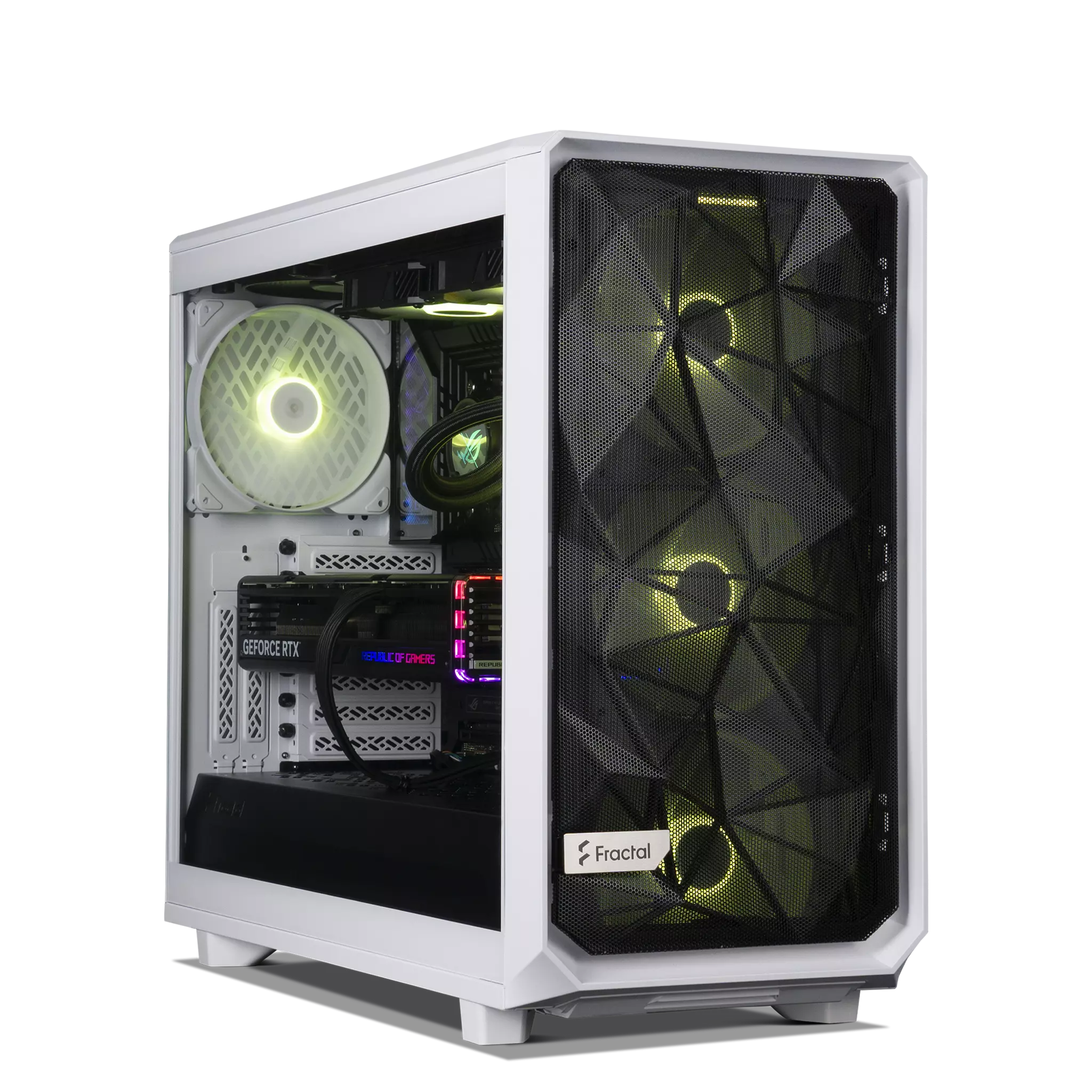
Apex Intel Core i9 RTX 4080 Racing Sim PC
This Chillblast Apex PC is a high-spec PC ready to enhance your sim racing experience with high frame rates and high performance, in even the most demanding of racing titles. The storage and memory options on this PC will ensure you're never held back from getting the fastest lap times, while the processor and graphics components offer next-level power for highly accurate racing. Keep your set up-cool and running smoothly when you're on a racing streak with the latest generation watercooler, and race free from distractions with near-silent, high-end cooling and power-supply features.
- Graphics: NVIDIA RTX 4080
- Processor: Intel Core i9 14th Gen
- Memory: 32GB DDR5 5600MHz
- Storage: 1TB NMVe SSD
Buy Now

Williams F1 Pro Intel Core i5 RTX 4070 Racing Sim PC
Race to the finish line in style with the iconic Williams F1 Pro racing sim PC! Packed with enough power for endless virtual racing, Pro features top-of-the-range components, including an impressively powerful Intel processor and epic GeForce RTX 4070 graphics that will ensure high accuracy and immersion. This Williams Edition Sim Racing PC won't slow you down, and it's the perfect PC if you're looking for a lower budget option that's still ready to compete to the highest standards as you beat your personal best again and again!
- Graphics: NVIDIA RTX 4070
- Processor: Intel Core i5 13th Gen
- Memory: 16GB DDR4 3200MHz
- Storage: 1TB NMVe SSD
Buy Now
If you're looking for something different for your sim racing set up, be sure to check out all of our PCs for sim racing here.
Conclusion
Building a sim racing setup can be one of the most rewarding projects in gaming. It’s bigger than most, and can take some time and consideration, especially if you end up building your own 8020 frame for it all. But the end result is well worth it.
After all your time, effort, and research, you’ll be able to play your favourite sim racing titles at a level of immersion that you could only dream about on a typical PC set-up.
If you want any help in putting together your plans, your design, or even are thinking of buying some racing sim gear through us, just get in touch. One of our sim racing experts will walk you through the whole process, and can advise you on exactly what you need to make your sim racing dreams a reality.


